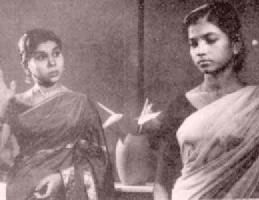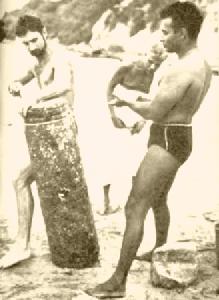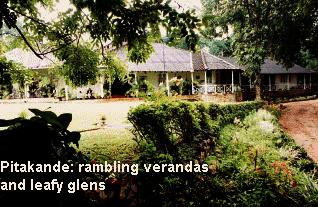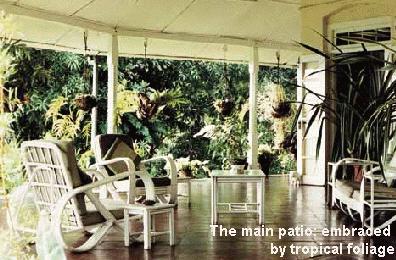 Year on the Web
Year on the Web Year on the Web
Year on the Web



In this three-part article, Richard Boyle documents the life of Mike Wilson (Swami Siva Kalki) 1934-1995, who among other things made a significant contribution to the Sinhala film industry, and pioneered underwater exploration around the island.
Continued from last week
The picture of a diver captioned 'Mike Wilson' published with last week's article was in fact of Rodney Jonklaas. The caption should have read 'Rodney Jonklaas in Beneath The Seas of Ceylon, 1958. Photo by Mike Wilson.'
Ranmuthu Duwa, the film in which Mike Wilson made his debut as a feature director also launched the career of Gamini Fonseka. And its compelling songs by Mahagama Sekera and W.D. Amaradeva are still played on the radio. 'I have never grown tired', enthuses Arthur C. Clarke, 'of watching the scenes of dawn over the great temples, the sea-washed cliffs of Trincomalee, the lines of pilgrims descending Adam's Peak, and the mysterious underwater sequences. For a first attempt at professional movie-making, it was an outstanding effort.'
The feature film industry in Ceylon was in its infancy at the time, and Wilson's contribution to the development of the industry - especially in the context of his being a Westerner - was considerable. It was not until 1956 that the country produced a film worthy of attention.
This was when Lester James Peries from the Government Film Unit to make Rekawa, a film deemed good enough to be shown at the Cannes Festival. "During the past few years", wrote Quinn Curtiss in the New York Herald Tribune of 27 July 1973, 'other directors have produced fine films, among them Titus Totawatte, Gamini Fonseka, Siri Gunasinghe, Herbert Seneviratne, and Mike Wilson.'
 A scene from Saravita
A scene from Saravita
Wilson's contribution to the Sinhala feature
film industry extended beyond his own directorial efforts, for he actively
encouraged other aspiring directors to make movies under the banner of his
company, Serendib Productions. One such film - a favourite of Wilson's - was
Saravita scripted by K.A.W. Perera and starring Joe Abeywickrema.
This delightful film was directed by Tissa Liyanasuriya, who had started as an assistant under Wilson and went on to become a prominent figure in the industry.
It was while filming Ran Muthu Duwa in 1962 that Wilson made an important maritime archaeological discovery that was to have a profound personal effect on his life. 'Discovery is very much a mental event, rather than a mere physical awareness of any given thing that one comes across', he used to assert.
This peak experience occurred in the sea around Swami Rock at Trincomalee.
When Jonklaas and Wilson had dived at this spot in 1956, the Brahmin had requested them to keep a special eye open for the lingam associated with the Konesar Temple.
'I was not aware then', Wilson admitted at a seminar on the maritime heritage of Sri Lanka held in Colombo in 1987, 'of the oral and written tradition concerning the emblem of God Siva, which was of peculiar significance and sanctity here, at Konesar Temple.'
During this initial dive, and subsequent ones in the diving seasons that followed, Wilson & Co. searched diligently for the lingam, but without success. 'All the columns and pillars we encountered' observes Clarke, 'had obviously been purely architectural, with alternating square and hexagonal sections. '
 Mike
Wilson and Gamini Fonseka with lingam, in 1962
Mike
Wilson and Gamini Fonseka with lingam, in 1962
Then one day in 1962,
while using the site as a film location for Ran Muthu Duwa, Wilson went for a
dive to cool off during a camera break. He suddenly perceived for the very
first time a perfectly circular pillar. He had found the lingam! Alongside it
was discovered a naturally rounded stone, the significance of which was not
realised until a little later.
Having delivered the lingam to the Konesar Temple where it was enshrined and has been worshipped ever since, Wilson returned to Colombo and made straight for the Museum Library. The librarian there produced two prime reference sources from which Wilson learnt of a special classification of linga, the Swayambhuwa, which are mounted on pedestals of natural stone. Of the 69 Swayambhuwa said to have been located in the Indian sub-continent, only a few still exist, such as the one at Swayambhuath in Nepal.
Wilson was convinced that the lingam and its pedestal recovered at Trincomalee was one of the original 69. He suspected that being seated alone in the presence of thet Swayambhuva formed part of a ritual. He had done so, and he said of the experience, 'One is aware of its enormous antiquity. And one's mind is able to soar back to the distant past and "see" all those who have sat there before'.
Wilson was enthusiastic about not only diving but all water sports, especially surfing, water-skiing and racing boats of every variety. Indeed one of his favourite occupations was racing his hydroplane Pegasus at breakneck speed across the Bolgoda Lake.
 A
scene from Getawarayo
A
scene from Getawarayo
It was apt then that Wilson forsook underwater
for the surface with his second feature Getawarayo, which Clarke describes as 'a
sort of "Wild-Ones-on-Water", with a climax out of Ben Hur, but
involving hydroplanes instead of chariots."
In 1966 Wilson started his third and possibly wackiest feature, Jamis Banda, which, as Clarke describes, 'pitted Hitler's illegitimate son against Sinhalese secret agent Jamis Banda. It had its good moments but the best was off-screen.
One day some innocent German tourists wandering around Galle came face to face with a group of SS officers. They must have wondered what had been happening while they were away from home.'
Before Wilson had completed the post-production of Jamis Banda, Clarke told him of an idea Satyajit Ray had for a vedic science fiction film. Wilson was intrigued by the idea and interested in raising international finance for the project, so he wrote inviting Ray to come to Colombo to discuss matters. Ray was too busy to leave Calcutta, and instead invited Wilson to come there, which he did.
Over a period of a fortnight, Wilson waited while Ray wrote a first draft screenplay. Wilson then sprung into action, setting up a meeting for Ray with Peter Sellers in Paris, and a few months later with Columbia Pictures in Hollywood, who were keen to back the film. Stupidly, however, Wilson copyrighted the script in his name as well as Ray's, an action that sowed the seeds of mistrust in the mind of the director.
The project was transferred to Columbia Pictures in London, to where Ray and Wilson subsequently travelled to try to clinch the deal. This trip ended disastrously, though, with Ray his mistrust fanned by Columbia executives eager to ease Wilson out of the project. For Ray the final blow came when Sellers announced his withdrawal, because he felt his role was not developed enough.
Later Wilson was persuaded to relinquish the copyright, and Columbia and others encouraged Ray to take up the project once again. This he never did, instead preferring to blame Wilson for the fact that the film remained unmade. The history of cinema is punctuated by a number of great 'might-have-beens', such as Sergei Eisenstein's Que Viva Mexico!
There is little doubt that The Alien falls into this category. The story behind it is a fascinating one - one I have attempted to piece together in my forthcoming book,The Wrecking : The story of Satyajit Ray's ill-fated science-fiction fllm project, The Alien.
(More next week)
 Camelot, that enchanted spot, the legendary seat of King Arthur's Court, was
re-created last weekend at St. Bridget's Convent. Past and present pupils of
the school joined to present Lerner and Loewe's popular musical adaptation of
Camelot. It was indeed a scintillating manifestation, both vocal and visual, of
the well loved Arthurian legend.
Camelot, that enchanted spot, the legendary seat of King Arthur's Court, was
re-created last weekend at St. Bridget's Convent. Past and present pupils of
the school joined to present Lerner and Loewe's popular musical adaptation of
Camelot. It was indeed a scintillating manifestation, both vocal and visual, of
the well loved Arthurian legend.
The spirit of medieval Camelot was highlighted outside the auditorium with banners hung along the way and large cutouts of the principal characters dominating the scene. The programme of scrolled manila paper accentuated the medieval effect.
The play was skillfully directed by Indu Dharmasena, a talented past pupil and well known playwright. Directing a cast of over eighty whilst playing the lead role of Arthur was no easy task. Nevertheless, Indu accomplished both functions admirably. She threw herself into the role of Arthur. She simply was Arthur. As one experienced theatre critic said, "Indu carried the show."
Arthur was ably and most enthusiastically supported by the rest of the cast comprising both past and present pupils of the school. Some of them were very young, the youngest being just four. They were natural and confident and seemed to be enjoying themselves greatly. All the principal characters portrayed their roles to near perfection.
Special mention must be made of Zulaiha Ghazaly as Guinevere, Naazima Kamardeen as Merlyn, Marissa Jansz as Mordred and Ruhanie Perera as King Pellinore. The role of Lancelot too was portrayed sensitively, although he seemed a trifle too boyish.
The credit for training the chorus singers and soloists goes to Ruwani Seimon Seneviratne. It was great listening. Excellent musical accompaniment was provided by Sundari David on the piano, assisted by Rocky Leitan on the double bass and Gayatri Aitken on the violin. Deanna Jayasuriya, also a past pupil of the school, was responsible for the choreography.
One shortcoming was perhaps the inadequacy of the sets. In some instances like the forest scenes, the sets left much to the imagination. The organizers say that unfortunately, the artist who undertook the contract for the sets had let them down and the sets were not completed in time. So they had to make do with what was available. It was all the more creditable that the sparkling performance more than made up for any shortcomins.-M.C
 The
first glimpse of the bungalow belonging to the Pitiakanda Group suggests
something special. Then the road to it twists around the bungalow's lower
garden and leads, as an anti-climax, to a car park at the back.
The
first glimpse of the bungalow belonging to the Pitiakanda Group suggests
something special. Then the road to it twists around the bungalow's lower
garden and leads, as an anti-climax, to a car park at the back.
 The
entrance, via a veranda that wraps around two thirds of the building, disguises
the impact of Pitiakanda. To see it in all its glory, a visitor must step out
onto the magnificent split-level lawns, walk to the edge of the upper one, and
turn around slowly.
The
entrance, via a veranda that wraps around two thirds of the building, disguises
the impact of Pitiakanda. To see it in all its glory, a visitor must step out
onto the magnificent split-level lawns, walk to the edge of the upper one, and
turn around slowly.
The sight, even to one accustomed to the eccentricities of plantation bungalow design, is enchanting. Pitiakanda seems to have been built for the fairies at the bottom of the garden, not for dour planters.
It is lent its ethereal appearance by the very veranda that gives it access. The columns are slight wooden posts, painted white, supporting a low roof of corrugated asbestos sheeting, the only solemn note in this light, plantation fantasy. Potted ferns and exotic plants hang from every beam and line every walkway. They transform the bungalow into a botanist's dream house.
The present occupant, Mr. S.B. Dissanayake, cheerfully confesses to having a collection of nearly 3,000 plants. On the plantation itself, rubber and coconuts are the main crop now, although there was tea in the Pitiakanda Group up to the 1950 s.
The Pitiakanda bungalow is at Mawatagama, about 14 km (nine miles) from the Kurunegala railway station. The plantation's elevation ranges from 700 to 1,000 feet above sea level, and the bungalow is designed to take advantage of the salubrious climes at that level.
The apex of its triangular layout is the main patio commanding a view of the lawns. White painted veranda chairs make relaxing there, embraced by tropical foliage, especially tranquil. Outdoor living comes naturally at Pitiakanda and the veranda doubles as a gallery giving access to the different parts of the bungalow.
The newest part is the annexe by which visitors gain access. This is known as the VVIP wing and is where special guests stay. The antique furniture in it has been painted white, a shock to purists but in keeping with the bright, botanical garden ambience of the bungalow.
The interior of the main section of the building also has features highlighted in white. Intriguing are the plaster crests, painted white and set into the ceiling of the living and dining rooms. What was their significance to the bungalow's original owners? Another relic from the building's beginnings are the ceiling fans. The blades have ends that curve upwards, instead of the flat, modern design.
 Two
bold arches divide the living and dining areas, creating wonderful visual
effects from different angles, accentuated by the creepers that trail down the
columns. The bungalow has five bedrooms and four bathrooms as well as a
servant's wing. That, being on the weather side, still has a roof of red tiles,
which must have been what originally covered the whole house.
Two
bold arches divide the living and dining areas, creating wonderful visual
effects from different angles, accentuated by the creepers that trail down the
columns. The bungalow has five bedrooms and four bathrooms as well as a
servant's wing. That, being on the weather side, still has a roof of red tiles,
which must have been what originally covered the whole house.
The bungalow's style seems typical of the 1920s. In the adjoining office, a board lists the planters in residence since 1928, which suggests that is when the bungalow was built. Curiously, in its first 50 years there were only six planters, while there have been nine in the last 17 years.
The layout of the bungalow, despite being open to the elements, creates alcoves of privacy where it is easy to while away time contemplating the garden's lush magnificence. The gardens are terraced, with a swimming pool below the level of the main lawn.
Sitting contentedly on the patio as a shower of rain lightly sprinkles the lawns and trees, you imagine you can hear the sprites of the glen gurgling with glee. This seems, above all, to be their home too.
Continue to Plus page 5 - The magic mountain: Sigiriya
Return to the Plus contents page







Please send your comments and suggestions on this web site to
info@suntimes.is.lk or to
webmaster@infolabs.is.lk